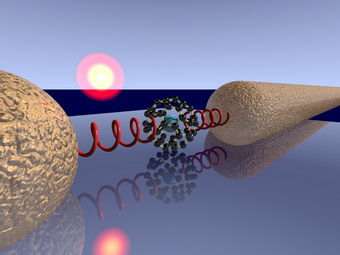June 5, 2006 feature
Shuttling Electrons

“We are trying to understand quantum nano-electro-mechanical systems,” Jason Twamley explains to PhysOrg.com. “These systems display richer dynamics and interactions than one can obtain with quantum optical systems, because it’s very hard to get photons to interact with each other.”
Twamley, a professor of quantum information science at Macquarie University in Sydney, Australia, worked with various colleagues, including theorists from the University of Queensland in St. Lucia, Australia and National Taiwan University in Taipei to develop a quantum nano-mechanical system that could measure the spin of a single molecule and perhaps be part of solid-state quantum computer. Their paper on the subject, “Spin-detection in a quantum electromechanical shuttle system,” appears in the May issue of the New Journal of Physics.
“Part of doing quantum computing,” Twamley explains, “is being able to input and output quantum bits (or qubits). If you are using a charge-based computer, you need to be able to read the charges. With spin-based, you need to read out spins.” Any quantum computer requires encoding quantum bits (qubits) into something. Twamley and his peers propose a readout device that would be able to detect changes in spin state of a single molecule, paving the way for spin-based input/output quantum computers in which qubits are inputted into the electron’s spin, and then decoded in the read-out to provide the asked-for information.
Twamley and his colleagues propose a mechanical system, simple and based on a mobile quantum dot, often referred to as a single electron shuttle, to provide the means for measuring differences in spin. “We’re combining the charge features of the quantum dot with the dot’s motion, a combination which most nanoelectronics don’t even contemplate doing.” And while nanoelectronic systems are quite new, Twamley points out that they are already pushing beyond that: “We’ve add a ‘q’ to the front of it: quantum nano-electro-mechanical systems. We’re now working in the quantum regime and the experiments are very close to the quantum regime now.”
The device comprises two electrodes, placed apart, and a quantum dot that acts as a shuttle, ferrying electrons from one to the other. Here’s how it works:
“The shuttle moves toward the source electrode. There is a bit of a gap between the two, called a tunnel gap. The shuttle doesn’t touch the electrode. Classically, the tunnel gap is not something that the electron could go through. On the quantum level, though, there is a chance. The electron jumps through the tunnel, and its charge forces the shuttle to the other electrode, called the drain electrode. The electron then jumps through another tunnel to the drain electrode and the whole process repeats.”
With the situation of the shuttle, the team discovered that it is possible to detect the spin. The spin on the shuttle causes the shuttle to move a tiny distance; this causes the current through the device to change. The change can be detected, measured, and interpreted, making it useful in a quantum computer or for spin-based classical computing, such as in the field of spintronics.
One possibility for the shuttle is a molecule known as a “doped Buckyball.” These molecules, only recently discovered, are composed of 60 carbon atoms surrounding either phosphorous or nitrogen. The trapped atom, either nitrogen or phosphorous, sits at the center of the carbon cage and the charge neutral molecule has an overall spin of 3/2. Putting a Buckyball between two contacts and introducing a nanomagnet results in the ability to move the molecule to the left or to the right, depending on the molecule’s spin, shifting the current and providing a change to measure.
Twamley readily admits that there are problems with the theory, the first being that the proposed device is a theory, and hasn’t been put into practice. “But,” he adds, “a lot of people are looking at these systems because such nano-electro-mechanical systems may yield ultra-precise measurements of the masses of biomolecules, and thus allow you to do bio-analysis on minute amounts of material.”
On top of that, creating a quantum computer adds other challenges, due to the somewhat-mysterious nature of quantum mechanics. “It’s pretty wide open at the moment. What you have to be careful about is encoding qubits in degrees of freedom that are long-lived. If noise couples with them, the qubits die quickly, and can’t be used.” The trick to overcoming this, Twamley says, is experimentation. “With condensed matter systems, once you do the experiment, and probe how healthy the qubits really are in that physical system, you will know how much noise you have, and what could be done with the qubits before they die.”
However, a mechanical device like that suggested by Twamley and his colleagues does have a clear advantage over optical quantum devices. “It’s hard to predict which technology will be used for quantum computing,” he explains. “But the nice thing about these nano-mechanical systems is that they interact with each other quite strongly as compared to optical systems.”
By Miranda Marquit, Copyright 2006 PhysOrg.com. All rights reserved. This material may not be published, broadcast, rewritten or redistributed.





















